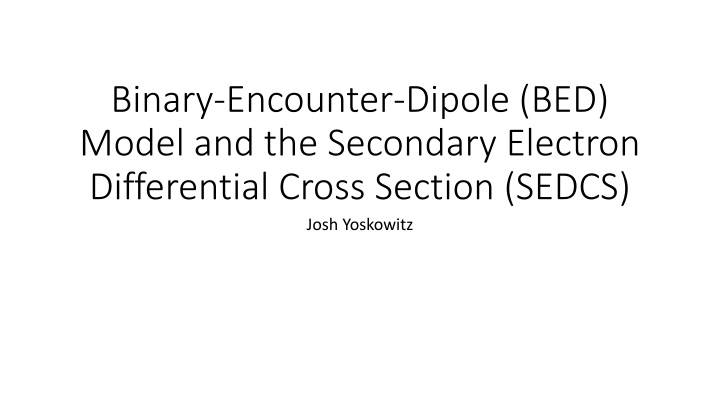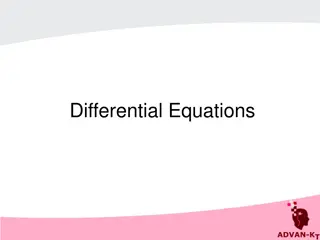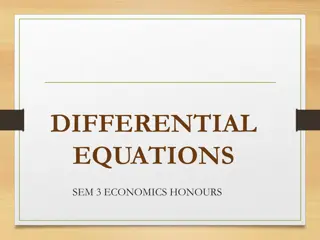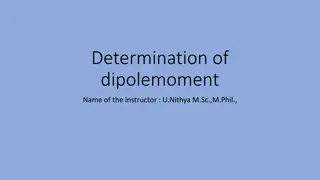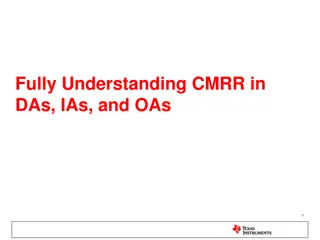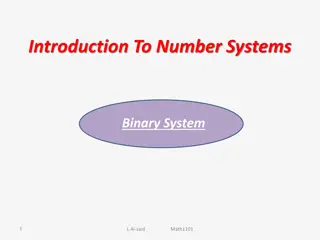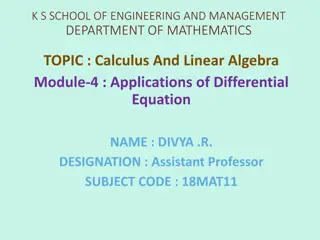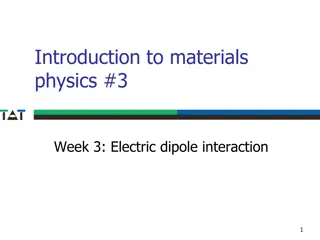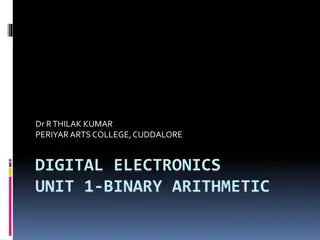Binary-Encounter-Dipole Model and the Secondary Electron Differential Cross Section
Delve into the Binary-Encounter-Dipole (BED) Model and the Secondary Electron Differential Cross Section (SEDCS) with a focus on the research conducted by Josh Yoskowitz. Explore the intricacies of this model and its implications in the field, providing valuable insights for further studies in related domains. Gain a comprehensive understanding of the interaction mechanisms at play and the nuances of electron scattering in various contexts.
Download Presentation

Please find below an Image/Link to download the presentation.
The content on the website is provided AS IS for your information and personal use only. It may not be sold, licensed, or shared on other websites without obtaining consent from the author.If you encounter any issues during the download, it is possible that the publisher has removed the file from their server.
You are allowed to download the files provided on this website for personal or commercial use, subject to the condition that they are used lawfully. All files are the property of their respective owners.
The content on the website is provided AS IS for your information and personal use only. It may not be sold, licensed, or shared on other websites without obtaining consent from the author.
E N D
Presentation Transcript
Binary-Encounter-Dipole (BED) Model and the Secondary Electron Differential Cross Section (SEDCS) Josh Yoskowitz
Description: Goals & Requirements BED model comes from Kim and Rudd (1994) article here: https://doi.org/10.1103/PhysRevA.50.3954 Goals: Fully describe electron-atom/molecule collisions i.e. given incident and target particle info, what are the characteristics (cross sections, energies) of the collision products (ion, secondary electron, scattered electron, etc.)? Model should not depend on fitted or adjustable parameters. Model should hold for both hard (small impact parameter) and soft (large impact parameter) collisions. Include electron exchange effect (since scattered and secondary electrons are indistinguishable after collision) Requirements: Parameters of the incident particle and target atom/molecule (obviously) Binding (ionization) energy of the target electron in a molecular/atomic orbital (available for most atoms/molecules) Average kinetic energy and differential oscillator strength (DOS) of electrons for all subshells (somewhat available from experiments, can be approximated).
Outline of SEDCS Derivation 1. Start with the Rutherford cross section for electron-atom/molecule collision 2. Modify Rutherford cross section to take into account the electron exchange effect for electron-electron (Mott cross section) 3. Modify Mott cross section to take into account the orbital motion of the electron (Binary encounter cross section) 4. Ensure that the model has the correct behavior in the asymptotic regions and is consistent with Bethe s theory through hand-waving arguments.
Deriving SEDCS: Rutherford cross section (Starting simple) For the case of an electron incident on a target particle with charge ?1?, the (differential) cross section ?? ?,? for a secondary electron energy ? is given by the Rutherford (differential) cross section: ?? ?,? ?? where ? is the Rydberg energy, ?0is the Bohr radius, and ? is the (non-relativistic) reduced kinetic energy of the incident electron, given by: ? =??2 ?? 2?1 ??2 2?2 =4??0 2 where ? is the relative speed of the electron w.r.t. the target particle and ? is the electron mass. Pros: Simple formula Good for electron-atom/molecule collisions Cons: Non-relativistic Doesn t take into account the recoil of the target particle (okay for heavy atoms/molecules) Inaccurate if both the incident and target particle are electrons (doesn t include exchange effect) Becomes infinite when either T or W goes to 0 (should be finite at least when W goes to 0)
Deriving SEDCS: Mott cross section (non- relativistic) Mott generalized the Rutherford cross section to take into account the exchange effect for two electrons: ?? ?,? ?? ? Notes: ? ? is interpreted as the kinetic energy of the scattered electron 1stterm is the direct collision term (from Rutherford formula) 3rdterm is the exchange collision term 2ndterm is the interference between the direct and exchange effects Pros: Takes into account the exchange effect Symmetric in kinetic energies of the scattered and secondary electrons Exact solution for two free electrons (still non-relativistic) Cons: Still becomes infinite when ? 0 or when ? ? 0 (i.e. ? ?). Both cases should be finite. 2?2 =4??0 1 1 1 ?2 + ? ?2 ? ? ?
Deriving SEDCS: Adding in the Binding Energy ? cannot equal ? for ionization, since ? must be greater than the binding (ionization) energy ?. We can account for this energy by replacing ? with the energy transfer ? = ? + ?. With this, the Mott cross section becomes: ?? ?,? ?? ? where ? is the number of bound electrons in the secondary electron s subshell of origin. Pros: No longer infinite when ?,?,? ? 0 Accurate for hard billiard ball like collision (binary collision) Becomes a good approximation when ? ? Cons: Only an approximation for a bound target electron (not sure why ) Neglects the orbital motion of the bound electron okay for fast collisions. Might not be okay for slow collisions 2?2? =4??0 1 1 1 ?2 + ? ?2 ? ? ?
Deriving SEDCS: Adding bound electron orbital motion We can take into account the orbital motion of the electrons in a subshell by adding a term to the Mott cross section involving the average kinetic energy ? = ?? ?,? ?? ? + ? + ? ? ? ? ?2 2?of electrons in the subshell: ? ?2+4? 3 2, we can rewrite this as: 1 ? + 1 ? ? 3 2?2? =4??0 1 1 1 1 1 ?2 + ?3+ ? ?3 Using energy variables ? =? ?? ?,? ?? ? ? + ? + 1 Pros: Takes into account the orbital motion of the electrons in a subshell based on the average kinetic energy Cons: The limit lim ? 1 and Bethe s theory, which predicts that lim Mott cross section does not take into account the dipole interaction between the incident electron and the target atom/molecule (important in soft/distant collisions) ?, ? =? ?, ? =? ? ? 2? ?, and ? = 4??0 1 ? ?2 ? 1 +4? 1 1 = ? + 12+ ? + 13+ ? ?3 ?? ?? ? 1(and hence ? = ?? ???? ? 1), is inconsistent with experiments ? 1? ? 1ln?. The reason for this is because the
Deriving SEDCS: Where do we go from here??? Problem: Need to correct the model to take into account the dipole interaction for fast collisions (Bethe s theory) while still ensuring correct behavior in the asymptotic energy cases. Solution: Recast cross section as a series: ?? ?,? ?? ?=1 Then figure out what the coefficients ??(?) should be to ensure the model is correct in all energy regions. For the binary encounter cross section (previous slide), the coefficients are: ?2 ? + 1,?2= Read section III in the article to understand how Kim and Rudd solved this problem. If you understand their solution, let me know because I don t. On the next slide, I will present the solution with some brief justification. 3 =? 1 1 ? ??(?) ? + 1?+ ? ?? 1 4? ?1= ? + ? + 1,?3= 3 ? + ? + 1
Deriving SEDCS: Final Equation for SEDCS ?? ? 2 ?+?+1,?3= ?2 ?+1,?2= ln? Choosing ?1= is consistent with Bethe s theory: ?+?+1leads to the SEDCS that has the correct behavior in the asymptotic regions and ?? ? ? + 1 2 ?? ?,? ?? ? 1 1 ?? ? 1 1 ln? ??(?) ?? = ? + 1+ + 2 ? + 12+ ? ?2+ ? ? + ? + 1 ? ? ? ? + 1 Notes: ?? ? ?? transition between energy states ?? ? ???? The term ? + 1 in the denominator of the SEDCS represents the acceleration of the incident electron due to the nuclear attraction , which is important for low ? ( I guess?) Correct Bethe behavior goes as ? 1ln? for high ?. ?? can be calculated from a power series: ? ? Kim & Rudd give values for ? ?,?,?, and ??only for H, He, H2, and Ne. Need to get values for ?? ? CO, CH3, and CH4 is the differential oscillator strength the probability of an electron absorbing/emitting EM radiation during the ?? 0 ?? ? ?? = ?? + ??2+ ??3+ ??4+ ??5+ ??6+ ??7where ? =? ? ? ??,?, and ??for
SEDCS For H2and He ?? ?,? ?? ?? ? ? + 1 2 ? 1 1 = ? + 1+ ? ? + ? + 1 ? ? ?? ? 1 1 ln? ??(?) ?? + 2 ? + 12+ ? ?2+ ? ? + 1 Parameter H2 He ? (eV) 15.43 24.59 ? (eV) 15.98 39.51 ?? 1.173 1.605 ??(?) ?? (H2) ??(?) ?? (He) ? (eV) W (eV) SEDCS H2 SEDCS He 3.15 10-24 8.92 10-25 100 10 1.74 1.60 7.78 10-25 2.94 10-25 1000 10 1.74 1.60 7.65 10-26 4.07 10-26 1000 100 0.877 0.904 1.26 10-27 7.26 10-27 130000 100 0.877 0.904 3.05 10-30 5.56 10-30 130000 1000 0.015 0.054
What about CO, CH3, and CH4? CO, CH3, and CH4 have multiple electron shells and thus, have multiple values for the average kinetic energy ? and occupation number ?. Kim, Rudd, Madison and Gay (1992) give values for ?, ?, and ? for each electron shell of CO and CH4 (as well as many other atoms/molecules). The NIST database also has these values for these molecules, as well as many other molecules. The differential oscillator strengths ?? ? though the SEDCS can be approximated using the Binary Encounter Bethe (BEB) model in section IV of Kim and Rudd (1994) assuming ??(?) simple form. This will be described in the next slide ??aren t given for CO, CH3, and CH4 , ?? has a
Binary Encounter Bethe (BEB) model to estimate the SEDCS without ??(?) ?? It is assumed that the differential oscillator strength can be represented by a power series in inverse powers of ? + 1 starting from ? + 1 2: ?? ??= where ? and ? are constants. Keeping the first term as an approximation, we can calculate ?? as ??= 0 ? ? ? + 12+ ? + 1 3+ ?? ???? = ? 0 ?? ?+12= ?. ?2 ?+1,?2= 1 ln? After some hand-waving, we choose ?1= The SEDCS is then: ?? ??= ? + ? + 1 ?+?+1,?3= ?+?+1. ? 1 1 1 1 1 1 1 ? ?2+ ? + 12 ? ?+ + ln? ? ?3+ ? + 13 ? + 1 1 + ?
SEDCS parameters (from NIST Database) and calculations CO, CH3, and CH4 using BEB model Parameters Calculated Values for 1 keV and 130 keV ?? ?? Molecule (orbital) B (eV) U (eV) N Molecule (orbital) T (eV) W (eV) CO (5?) 14.01 42.26 2 2.22 10-23 CO (5?) 1000 100 CO (1?) 17.66 54.30 4 2.29 10-25 CO (5?) 130000 100 CO (4?) 21.92 73.18 2 7.84 10-24 CH3 (1?2) CH3 (1?2) 1000 100 CO (3?) 41.92 79.63 2 7.56 10-26 130000 100 CH3 (2?1) CH3 (1e) CH3 (1a2) CH4 (2a1) CH4 (1t2) 24.57 34.18 2 6.86 10-23 CH4 (1t2) 1000 100 15.64 26.46 4 7.02 10-25 CH4 (1t2) 130000 100 9.84 30.40 1 25.73 33.05 2 14.25 25.96 6
